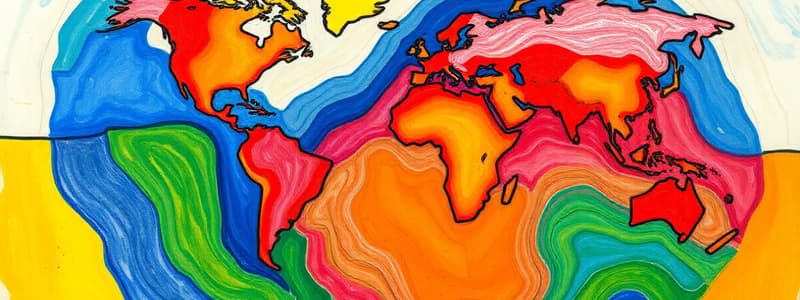Podcast
Questions and Answers
Which of the following statements best describes the theory of plate tectonics?
Which of the following statements best describes the theory of plate tectonics?
- The Earth's surface is static and unchanging, with mountains and valleys formed by erosion alone.
- The Earth's surface is composed of large, rigid plates that move on a softer layer called the asthenosphere. (correct)
- Continents drift randomly across the Earth's surface without any underlying mechanism.
- The Earth's surface is a single, unbroken layer that expands and contracts due to changes in temperature.
What is the primary difference in thickness between continental and oceanic plates?
What is the primary difference in thickness between continental and oceanic plates?
- The thickness of plates depends on the temperature.
- Continental plates are generally thinner than oceanic plates.
- Continental plates can be significantly thicker than oceanic plates. (correct)
- Oceanic plates and continental plates have roughly the same thickness.
Using the provided analogy, which layer of the Earth does the 'fruit' of an apple best represent?
Using the provided analogy, which layer of the Earth does the 'fruit' of an apple best represent?
- The Earth's crust
- The Earth's core
- The Asthenosphere
- The Earth's mantle (correct)
The Earth's core is composed of which two layers?
The Earth's core is composed of which two layers?
Which statement accurately describes the relationship between plate boundaries and continental boundaries?
Which statement accurately describes the relationship between plate boundaries and continental boundaries?
Which of the following best describes the role of radioactive decay in plate tectonics?
Which of the following best describes the role of radioactive decay in plate tectonics?
In the context of mantle convection, what is analogous to the 'stove' in the analogy of heating a pot of water?
In the context of mantle convection, what is analogous to the 'stove' in the analogy of heating a pot of water?
What is the primary force driving 'ridge push' at mid-ocean ridges?
What is the primary force driving 'ridge push' at mid-ocean ridges?
How do ocean trenches contribute to plate movement?
How do ocean trenches contribute to plate movement?
Which of the following scenarios best illustrates the interaction between mantle convection and plate movement?
Which of the following scenarios best illustrates the interaction between mantle convection and plate movement?
Flashcards
Plate Movement Theory
Plate Movement Theory
Heat from the Earth's core causes convection cells in the mantle, which move the plates above.
Source of Mantle Heat
Source of Mantle Heat
The radioactive decay of elements like uranium.
Convection Current
Convection Current
A cycle of hot material rising and cool material sinking due to temperature differences.
Ridge Push
Ridge Push
Signup and view all the flashcards
Slab Pull
Slab Pull
Signup and view all the flashcards
Plate Tectonics
Plate Tectonics
Signup and view all the flashcards
Asthenosphere
Asthenosphere
Signup and view all the flashcards
Lithosphere
Lithosphere
Signup and view all the flashcards
Mantle
Mantle
Signup and view all the flashcards
Core
Core
Signup and view all the flashcards
Study Notes
- Plate tectonics is the theory that the Earth's surface is broken into large crustal pieces called plates.
- These plates move on a softer layer called the asthenosphere, the upper part of the mantle.
- Plate tectonics explained continental drift and tied together geological observations.
Plate Thickness and Boundaries
- Continental plates are up to 150 km thick.
- Oceanic plates average about 5-10 km thick.
- Plate boundaries differ from continental boundaries and can be underwater.
- The North American plate extends from the mid-Atlantic Ocean to North America's west coast.
Causes of Plate Movement
- Heat from Earth's core causes convection cells in the mantle, moving the plates.
- Radioactive decay of uranium and other elements generates heat
- The heat softens the rock, allowing it to flow over thousands of years.
- Hot rock rises toward the crust, while cooler rock sinks back toward the core, forming convection currents.
Additional Causes
- Convection currents encounter the crust, causing plate movement.
- Plate movement leads to plates colliding, sliding, or being pushed under each other.
- Ridge push contributes to plate movement.
- Plates higher at the spreading center flow downhill due to gravity.
- Ridge push forces new crust up at the fault, and subsequent movement.
- Oceanic crust can be forced under another plate at converging boundaries.
- Deep ocean trenches indicate where one plate slides under another.
- As a plate slides under, gravity helps pull it along, adding to the force.
- Trenches are created when oceanic plates are forced under other plates.
Studying That Suits You
Use AI to generate personalized quizzes and flashcards to suit your learning preferences.
Description
Explore the theory of plate tectonics, explaining that Earth's surface is divided into large crustal plates. Learn about plate thickness, boundaries, and the underlying causes of plate movement, including mantle convection and radioactive decay. Discover how these plates drift.




